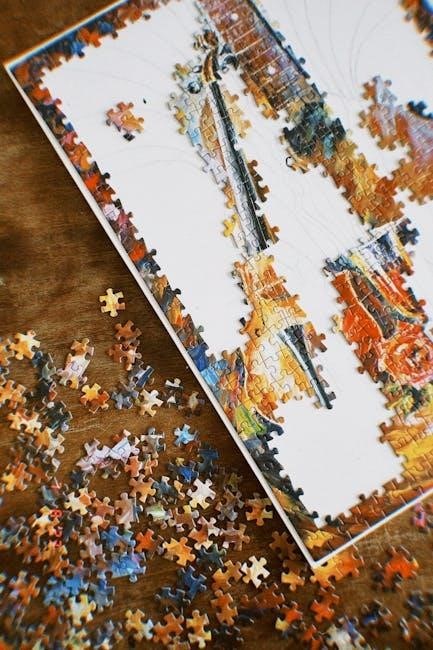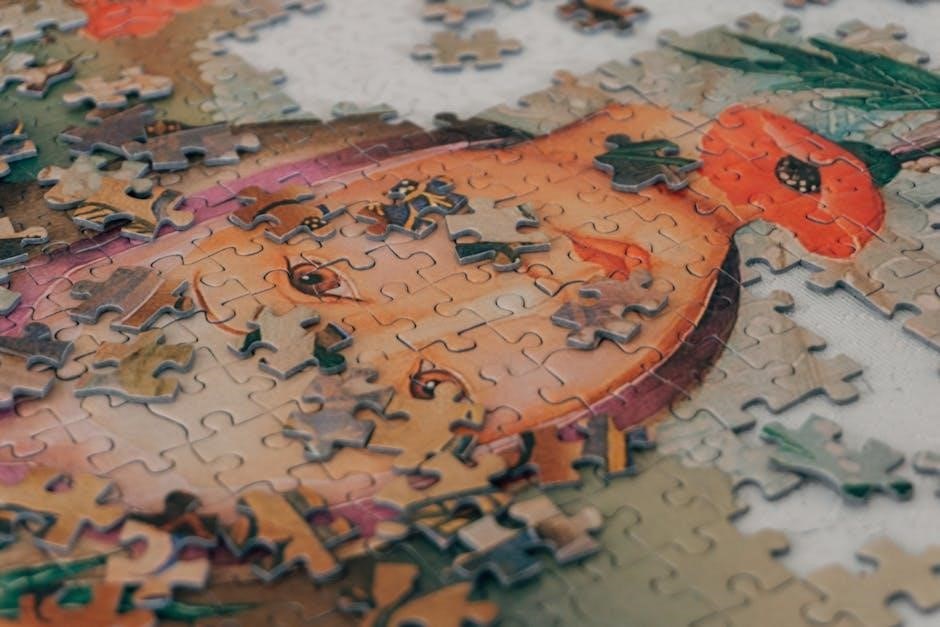Edvard Grieg’s Lyric Pieces are a collection of 66 short solo piano works, showcasing Norwegian folk influences and intimate emotional depth․ Composed between 1867 and 1901, these pieces reflect Grieg’s mastery of lyrical expression, blending simplicity with profound musicality․ The collection remains a cornerstone of piano repertoire, offering a glimpse into Grieg’s artistic soul and enduring appeal․
1․1 Overview of the Collection
Edvard Grieg’s Lyric Pieces comprise 66 short works for solo piano, published in 10 volumes between 1867 and 1901․ These pieces blend Norwegian folk elements with romantic-era expressiveness, offering a diverse range of moods and styles․ The collection is celebrated for its lyrical simplicity, emotional depth, and timeless appeal, making it a beloved part of piano repertoire worldwide․
1․2 Historical Significance
Edvard Grieg’s Lyric Pieces hold a vital place in the Romantic-era piano repertoire, reflecting Norway’s cultural identity through folk-inspired themes․ Composed over three decades, the works showcase Grieg’s evolution as a composer while preserving his nationality․ Their enduring popularity highlights their influence on later composers and their role in shaping Romantic musical heritage․
1․3 Popularity and Reception
Grieg’s Lyric Pieces gained immediate acclaim for their lyrical beauty and emotional depth․ Their accessibility and intimate charm resonated with both pianists and audiences, making them a cornerstone of Romantic piano repertoire․ The collection’s popularity endures, with pieces like “Wedding Day at Troldhaugen” remaining favorites, reflecting their timeless appeal and universal emotional resonance․
Structure and Composition of Lyric Pieces
Grieg’s Lyric Pieces consist of 66 short piano works, published in 10 volumes between 1867 and 1901․ These intimate compositions blend Norwegian folk elements with Romantic expressiveness, creating a rich tapestry of emotional depth and cultural resonance․
2․1 Opus Numbers and Publication Details
Grieg’s Lyric Pieces span 10 volumes, published between 1867 and 1901, with opus numbers including Op․12, Op․38, Op․43, Op․47, Op․54, Op․57, Op․62, Op․65, Op․68, and Op․71․ Each volume contains 6-8 pieces, reflecting Grieg’s evolving style and emotional depth․ The complete PDF editions compile these works, offering pianists a comprehensive collection of Grieg’s lyrical mastery․
2․2 Key Characteristics of the Music
Grieg’s Lyric Pieces are characterized by lyrical melodies, Norwegian folk influences, and a blend of simplicity with emotional depth․ They often feature expressive phrasing, delicate harmonies, and a sense of intimacy․ The pieces range from playful to melancholic, showcasing Grieg’s ability to evoke vivid imagery and emotional resonance through his unique compositional style․
2․3 Notable Works Within the Collection
Grieg’s Lyric Pieces include notable works like “Wedding Day at Troldhaugen” and “Arietta,” showcasing his mastery of lyrical expression․ Pieces such as “Albumblatt” and “Elegie” highlight his ability to blend simplicity with emotional depth․ These works are celebrated for their technical challenges and emotional resonance, making them favorites among pianists and audiences alike․

Complete Lyric Pieces for Piano
Grieg’s Lyric Pieces comprise 66 works, spanning his entire compositional career․ These pieces, published in 10 volumes, showcase a range of styles, from folk-inspired melodies to delicate, expressive miniatures․
3․1 Total Number of Pieces and Their Distribution
Edvard Grieg’s Lyric Pieces consist of 66 works, published in 10 volumes between 1867 and 1901․ Each volume contains 6–8 pieces, with opus numbers ranging from Op․12 to Op․71․ The collection includes notable works like Arietta (Op․12, No․1) and Wedding Day at Troldhaugen (Op․65, No․6)․ These pieces are distributed across various keys and styles, reflecting Grieg’s evolving compositional technique and his deep connection to Norwegian folklore․ Their diversity and charm have made them a beloved part of piano repertoire․
3․2 Specific Pieces and Their Titles
Notable pieces include Arietta (Op;12, No․1), Wedding Day at Troldhaugen (Op․65, No․6), Erotik (Op․43, No․5), and To Spring (Op․43, No․6)․ Titles like Melody (Op․47, No․3) and Illusion (Op․57, No․3) reflect Grieg’s lyrical and expressive style, blending Norwegian folklore with romanticism․ These works showcase his ability to evoke emotion through simple yet profound melodies․
3․3 Musical Styles and Influences
Grieg’s Lyric Pieces blend Norwegian folk melodies with Romantic-era harmonies, showcasing his ability to merge simplicity with emotional depth․ Influenced by composers like Schumann and Chopin, Grieg’s works often feature delicate phrasing, lyrical elegance, and a strong connection to Norwegian culture․ His use of folk elements creates a unique, intimate sound, balancing tradition with innovation․
Arrangements and Transcriptions
Grieg’s Lyric Pieces have been transcribed for various instruments, including guitar, bassoon, and chamber ensembles, expanding their reach beyond solo piano․ These arrangements maintain the original’s lyrical essence while adapting to new instrumental voices, showcasing the music’s versatility and timeless appeal․
4․1 Versions for Other Instruments
Grieg’s Lyric Pieces have been transcribed for guitar, bassoon, and chamber ensembles, preserving their lyrical essence․ Notably, William Goodman arranged Op․ 71 for bassoon and piano, maintaining the original’s emotional depth․ These adaptations highlight the music’s versatility and enduring appeal across instrumental settings․
4․2 Guitar and Chamber Music Arrangements
Grieg’s Lyric Pieces have been beautifully transcribed for guitar and chamber ensembles, preserving their lyrical charm․ Guitar arrangements, such as Op․ 12 and Op․ 38, are particularly popular, offering intimate interpretations․ Chamber music adaptations, including string quartet versions, further expand the pieces’ reach, maintaining their emotional depth while introducing new textures․ These arrangements are widely available as PDF downloads․
4․3 Modern Interpretations and Adaptations
Grieg’s Lyric Pieces have inspired modern adaptations, including arrangements for bassoon and piano, and contemporary electronic reinterpretations․ These works are available as downloadable PDFs, allowing for fresh exploration․ Modern artists continue to reimagine the pieces, blending traditional melodies with innovative styles, ensuring their timeless appeal endures across generations and musical genres․

Sources for Downloading the Complete PDF
The complete PDF of Grieg’s Lyric Pieces is available from official publishers like Dover Publications and Alfred Music, as well as online platforms such as Gum․co and Scribd․
5․1 Official Publishers and Editions
Dover Publications and Alfred Music offer high-quality editions of Grieg’s Lyric Pieces․ Dover’s complete scores are known for clarity and authenticity, while Alfred Music provides adaptations for various skill levels, ensuring accessibility for pianists worldwide․ These editions are trusted sources for both professionals and enthusiasts, maintaining the composer’s original intent and musical integrity․
5․2 Online Platforms and Marketplaces
Popular platforms like Gum․co, Scribd, and Sheet Music Plus offer Grieg’s Lyric Pieces in PDF format․ These sites provide direct downloads, ensuring easy access to the complete collection․ They cater to pianists of all levels, offering various editions, from original scores to adapted arrangements, making Grieg’s timeless music readily available for study and performance․
5․3 Free and Paid Resources
Free resources like IMSLP and Musopen offer select Lyric Pieces in PDF, ideal for casual access․ Paid options, such as Alfred Music and Dover Publications, provide high-quality, complete editions with additional features․ Marketplaces like Sheet Music Plus and Musicnotes also offer individual pieces or the full collection, ensuring access to both free and premium versions for pianists․

Performance and Interpretation
Pianists must balance technical precision with expressive nuance, capturing Grieg’s emotional depth and cultural essence in each piece, ensuring a compelling and authentic interpretation of his lyrical works․
6․1 Technical Challenges
The Lyric Pieces present pianists with intricate phrasing, nuanced pedaling, and dynamic control challenges․ Maintaining clarity in delicate passages, managing tempo rubato, and balancing contrasting moods require precision and interpretive skill, ensuring technical mastery aligns with emotional expression․
6․2 Expressive Elements
Grieg’s Lyric Pieces are rich in expressive elements, including delicate articulations, dynamic contrasts, and phrasing that evokes Norwegian folklore․ Pianists must convey the emotional depth of each piece through subtle variations in touch and tempo, capturing the essence of Grieg’s lyrical intent and cultural inspiration․
6․3 Historical Performance Practices
Grieg’s Lyric Pieces benefit from historically informed practices, emphasizing nuanced phrasing, dynamic contrasts, and expressive rubato․ Pianists should adhere to Grieg’s markings while interpreting the folk-inspired themes with sensitivity․ The use of pedal techniques and attention to articulation are crucial, reflecting the Romantic era’s expressive traditions and Grieg’s cultural heritage․

Editions and Sheet Music Quality
Dover Publications and Alfred Music offer high-quality editions of Grieg’s Lyric Pieces, ensuring clarity and accuracy․ These scores preserve the composer’s intent, making them ideal for performance and study․
7․1 Dover Publications Edition
Dover Publications’ edition of Grieg’s Lyric Pieces is renowned for its clarity and fidelity to the original manuscripts․ This edition presents the complete 66 pieces in a clean, unmarked format, ideal for pianists seeking an authentic performance experience․ The quality of reproduction ensures that every nuance of Grieg’s composition is preserved, making it a preferred choice among musicians and scholars alike․
7․2 Peer Gynt Suite and Other Works
The Dover Publications edition also includes Grieg’s iconic Peer Gynt Suite and Holberg Suite, offering a comprehensive collection of his most celebrated works․ These pieces, alongside the Lyric Pieces, showcase Grieg’s mastery of Norwegian folklore and romanticism․ The edition’s clarity and fidelity to the original scores make it a valuable resource for pianists and enthusiasts alike․
7․3 Alfred Music Edition
The Alfred Music Edition of Grieg’s Lyric Pieces offers meticulously edited scores, ensuring clarity and fidelity․ Designed for pianists of all levels, it includes performance notes and historical insights, enhancing both study and performance․ This edition is celebrated for its accessibility and faithfulness to Grieg’s original compositions, making it a preferred choice among musicians․
Legacy and Cultural Impact
Grieg’s Lyric Pieces have left an indelible mark on classical music, inspiring countless composers and adaptations․ Their timeless beauty resonates in films, literature, and modern interpretations, ensuring Grieg’s enduring legacy․
8․1 Influence on Later Composers
Grieg’s Lyric Pieces profoundly influenced later composers, inspiring a generation to explore nationalism and lyrical expression․ Composers like Bartók and Dvořák drew from Grieg’s integration of folk elements, while his harmonic simplicity and melodic charm continue to inspire modern musicians, cementing his legacy as a foundational figure in classical music history․
8․2 Use in Popular Culture
Grieg’s Lyric Pieces, particularly “Wedding Day at Troldhaugen,” have been widely used in films, commercials, and media, enhancing emotional scenes with their evocative melodies․ Their timeless appeal makes them a popular choice for soundtracks, ensuring Grieg’s music remains a cultural staple and continues to resonate with modern audiences․
8․3 Educational Significance
Grieg’s Lyric Pieces are essential in piano education, offering pieces that range from simple to complex, making them accessible to students of all levels․ They teach lyrical phrasing, nuanced pedaling, and expressive dynamics, fostering technical and artistic growth․ Their inclusion in syllabi worldwide underscores their enduring value as pedagogical material․
Guides for Accessing the Complete PDF
Access Grieg’s Lyric Pieces PDF through reputable publishers like Dover and Alfred Music․ Ensure legality by purchasing from authorized platforms, respecting copyright laws and supporting artists․
9․1 Step-by-Step Download Instructions
Visit a reputable music retailer or publisher’s website, such as Dover Publications or Alfred Music․ Search for “Grieg Lyric Pieces Complete PDF․” Select the desired edition, add to cart, and proceed to checkout․ After payment, download the PDF directly from the site․ Ensure your device has a PDF reader installed for viewing․
9․2 Legal and Copyright Considerations
Ensure you download the complete PDF from authorized sources to comply with copyright laws․ Many editions of Grieg’s Lyric Pieces are in the public domain, but specific publications may still be under copyright․ Always verify the legality of the source and respect intellectual property rights to avoid infringement․ Using official publishers guarantees compliance․
9․3 Recommended Software for Viewing
Use Adobe Acrobat Reader, Foxit Reader, or SumatraPDF for optimal PDF viewing․ These tools offer clarity, annotation features, and cross-platform support․ For Mac users, Preview is a reliable option․ Ensure software is updated for the best experience․ These viewers enhance readability and functionality, making it easier to explore Grieg’s Lyric Pieces in high quality․
Edvard Grieg’s Lyric Pieces are timeless masterpieces, offering deep emotional resonance and cultural richness․ The complete PDF collection is a valuable resource for pianists, educators, and enthusiasts, ensuring Grieg’s legacy endures for future generations to explore and appreciate․
10․1 Final Thoughts on the Collection
Edvard Grieg’s Lyric Pieces stand as a testament to his genius, blending Norwegian folk elements with romantic expression․ The complete PDF collection offers pianists a comprehensive journey through his artistry, from delicate simplicity to profound depth․ These works remain essential for both performance and study, captivating audiences with their timeless beauty and emotional resonance․
10․2 Encouragement for Exploration
Exploring Grieg’s Lyric Pieces offers a profound musical journey, blending Norwegian folk charm with romantic elegance․ Pianists and music enthusiasts alike will find inspiration in these works, which showcase Grieg’s lyrical genius․ Embrace the opportunity to delve into this timeless collection, available in complete PDF format, and discover the beauty of Grieg’s artistic legacy․

